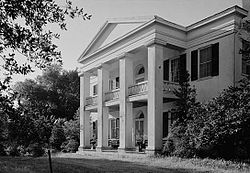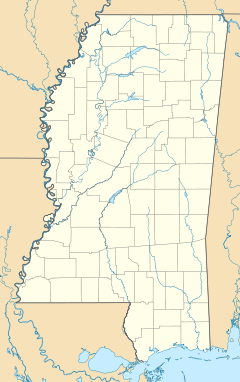- Monmouth (Natchez, Mississippi)
-
Monmouth PlantationMississippi Landmark
 Monmouth in 1972
Monmouth in 1972Location: 36 Melrose Ave, Natchez, Mississippi Coordinates: 31°33′12″N 91°23′13″W / 31.553296°N 91.386844°WCoordinates: 31°33′12″N 91°23′13″W / 31.553296°N 91.386844°W Built: 1818 Architectural style: Greek Revival Governing body: Private NRHP Reference#: 73001001 USMS #: 001-NAT-4018-NHL-ML Significant dates Added to NRHP: April 26, 1973[2] Designated NHL: June 7, 1988[3] Designated USMS: October 17, 1986[1] Monmouth Plantation is a historic plantation on a 30-acre (12 ha) lot built in 1818 by John Hankinson and inhabited by John A. Quitman, a former Governor of Mississippi and well known figure in the Mexican-American War. It was declared a Mississippi Landmark in 1986[1] and a National Historic Landmark in 1988.[3][4]
Contents
History
John Hankinson, a postmaster in Natchez, built Monmouth in 1818, during the depression that followed the War of 1812. During a yellow fever outbreak in the city shortly thereafter, Hankinson and his wife caught the disease and died. In 1825, the house was sold at a public auction to Calvin Smith, who one year later sold the property to John Anthony Quitman, the future Governor of Mississippi.[5] Quitman stayed in the house until his death in 1858 and became well known for volunteering in the movement for Texan independence in 1835 and for fighting in the Mexican-American War.[4]
When Quitman purchased the plantation, the house had a cellar under half of it, a detached brick kitchen behind it, a garden house, and several outhouses. Originally a Federal style house, the house was extensively renovated by Quitman in 1853 in Greek Revival style. The original brick was covered by stucco, and the portico was added to the front, along with the four square columns supporting it. Quitman also added the rear gallery and southeast wing of the house, along with a second story for the detached kitchen.[4]
After Quitman died at the plantation on July 17, 1858, and his wife died a year later, their three daughters married and remained at the plantation. In 1862 when Natchez was attacked by the Union army during the American Civil War, most of the slaves escaped, and some joined the Union forces. Most of Quitman's original possessions were either stolen in 1863, when the house was occupied by Union soldiers, or sold by Quitman's daughters in 1865 due to financial difficulty. In 1914 the last surviving daughter of John Quitman died, leaving the house to her nieces, who later sold it in 1924.[6]
Monmouth Plantation Timeline
1818 - Monmouth is built in 1818, by Natchez postmaster, John Hankinson.
1824 - John A. Quitman purchases Monmouth as home for his wife Eliza Turner and newborn daughter, Louisa.
1833 – Cholera claims Quitman’s infant sons, John and Edward. An enslaved woman at Monmouth named Aunt Dicey is put into service as a nursemaid to Eliza and John Quitman’s children.
1834 – Quitman purchases fifty slaves. A house slave at Monmouth name Harry Nichols is put into service as personal valet to John Quitman.
1836 - Harry Nichols travels with Quitman to Texas. Quitman participates in Texas Independence over Mexico.
1842 – John and Eliza’s family grows to seven children. Aunt Dicey is “banished” to Springfield Plantation by Eliza for “misbehaving”.
1846 – John Quitman serves as a victorious general in the war with Mexico he is assisted by “faithful” Harry Nichols. Quitman procures a daguerreotype of Harry.
1850 – John Quitman becomes Governor of Mississippi. A Monmouth house slave named Belle Vessels assists at the “White House of Mississippi”.
1856 – Aunt Dicey is allowed back at Monmouth. Viola Vessels, a Monmouth house slave, is bridesmaid at the wedding of enslaved couple at neighboring Melrose, a suburban estate owned by Quitman’s law partner, John McMurran. Viola is married the following year to Marcellus Brannick, a house slave at Melrose.
1858 – Quitman dies at Monmouth. His wife Eliza dies at Monmouth one year later. Daughters Annie Rosalie, J. Antonia, and Louisa marry and remain at Monmouth.
1861 – The state of Mississippi secedes from the Union. The Quitman daughters see their husbands off to war. Monmouth slaves are asking, “how’s master”?
1862 – Natchez surrenders to the Union Army. Monmouth house slaves begin to run off, including Monmouth house slaves Charles Vessels, Richard Austin and Isaac, all of whom join the Union Army.
1863 – Monmouth is occupied by Union Soldiers whereupon extensive looting occurs. Harry Nichols joins the Union Army, and then returns to Monmouth “demanding wages”. Quitman daughters begin paying wages to eight former house slaves. Aunt Dicey and Old Sarah are compensated in their old age.
1865 – The only staff left at Monmouth is “Fred and his family along with Harry and his wife”. Surviving Quitman daughters sell of f Monmouth’s household possessions to former Monmouth enslaved to supplement their income.
1875 – A Lease/Lien agreement is signed with John Williams, giving the Quitman daughters a lien on any cotton grown on Monmouth premises for the payment of rent.
1887 – John Quitman’s granddaughters, Eva C. Lovell and Alice Lovell, move back to Natchez and take up residence at Monmouth. Viola Vessels Brannick’s daughters, Corinne and Hester, childhood companions to Evan, return to Monmouth as paid staff.
1902 – Belle Vessles, a former house slave to Governor Quitman at the “White House of Mississippi”, lives at the edge of Monmouth where she and her husband rent Monmouth land for crops. One year later Quitman’s daughter, Annie Rosalie Quitman Duncan, sell a half acre of Monmouth to Viola Brannick (a widow) for the sum of $200.
1912 – Corrine Scott “a colored woman” who grew up at Monmouth purchases from Rose Duncan one-half acre of Monmouth property as “her residence for the sum of $100”. Former house slave, Charles Vessels also purchases a portion of Monmouth property.
1914 – Annie Rosalie Quitman Duncan, the last surviving child of John and Eliza Quitman, dies at Monmouth, leaving Monmouth to her nieces, Eva Lovell and Alice Lovell. Descendents of Monmouth enslaved and staff, Corinne Scott, Frank Tolles, Viola Brannick, and Kitty Austin are listed as beneficiaries in “Aunt Rose’s” will.
1924 – Monmouth passes from the hands of Quitman descendents when it is sold to Annie Gwen. Corrina (Corinne) Scott sells her portion of Monmouth to Mamie Davis for $500.
1978 - Ronald and Lani Riches purchase and begin restoration of Monmouth after decades of neglect.
Restoration
After several changes of ownership, Mr. and Mrs. Ron Riches of Los Angeles, California, purchased the property in 1978 and planned to restore it to its original condition. The restoration of the house took three years and restored the use of the plantation's two gasoliers and two gas sconces along with the original brick kitchen. In 1982, after archaeological research determined the location of two small houses used as slave quarters, the buildings were reconstructed on the original sites. Though most of John Quitman's original furnishings had been lost, the house still contained a few pieces such as a sofa, a carved settee, and several chairs. The Riches searched for other furniture and memorabilia from Quitman, and they were able to recover his desk, two four-poster beds, and the Quitman family bible. Other memorabilia now include the gold sword presented to Quitman by James K. Polk and the United States Congress for his services in the Mexican-American War, as well as the red handkerchief Quitman used to rally his troops.[4]
References
- ^ a b "Mississippi Landmarks". Mississippi Department of Archives and History. May 2008. http://mdah.state.ms.us/hpres/MSLandmarks.pdf. Retrieved April 20, 2009.
- ^ "National Register Information System". National Register of Historic Places. National Park Service. 2007-01-23. http://nrhp.focus.nps.gov/natreg/docs/All_Data.html.
- ^ a b "Monmouth Plantation". National Historic Landmark summary listing. National Park Service. http://tps.cr.nps.gov/nhl/detail.cfm?ResourceId=1343&ResourceType=Building. Retrieved 2007-10-23.
- ^ a b c d Susan Enzweiler and Dawn Maddox (June, 1987). National Register of Historic Places Inventory-Nomination: MonmouthPDF (542 KB). National Park Service and Accompanying 9 photos, exterior and interior, from 1987.PDF (2.68 MB)
- ^ "Monmouth Plantation". Natchez On The River. http://www.natchezontheriver.com/news/2008/oct/13/monmouth/. Retrieved April 23, 2009.
- ^ "Monmouth Timeline". Monmouth Plantation. Luxury Hotel Mississippi. http://www.monmouthplantation.com/contents/index.php?PG=timeline.html&nav_id=14/43. Retrieved April 23, 2009.
External links
U.S. National Register of Historic Places Topics Lists by states Alabama • Alaska • Arizona • Arkansas • California • Colorado • Connecticut • Delaware • Florida • Georgia • Hawaii • Idaho • Illinois • Indiana • Iowa • Kansas • Kentucky • Louisiana • Maine • Maryland • Massachusetts • Michigan • Minnesota • Mississippi • Missouri • Montana • Nebraska • Nevada • New Hampshire • New Jersey • New Mexico • New York • North Carolina • North Dakota • Ohio • Oklahoma • Oregon • Pennsylvania • Rhode Island • South Carolina • South Dakota • Tennessee • Texas • Utah • Vermont • Virginia • Washington • West Virginia • Wisconsin • WyomingLists by territories Lists by associated states Other  Category:National Register of Historic Places •
Category:National Register of Historic Places •  Portal:National Register of Historic PlacesCategories:
Portal:National Register of Historic PlacesCategories:- Antebellum architecture
- National Historic Landmarks in Mississippi
- Buildings and structures completed in 1818
- Historic house museums in Mississippi
- Museums in Natchez, Mississippi
- Mississippi Landmarks
Wikimedia Foundation. 2010.

